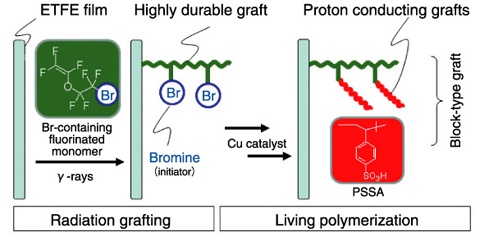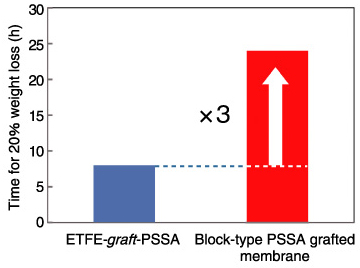
Fig.4-15 Schematic scheme for the synthesis of a block type graft membrane

Fig.4-16 Oxidative stability of ETFE-graft-PSSA and the block type graft membrane
Polymer electrolyte membrane fuel cells have been intensively investigated for application in domestic cogeneration systems and fuel cell vehicles. Both high proton conductivity and thermal durability are required in a polymer electrolyte membrane (PEM), which determines fuel cell performance.
Radiation-induced graft polymerization has been widely recognized as a preparation method for a high performance fuel cell PEM because in graft polymerization, the characteristics of substrate polymer films, such as thermal stability and mechanical strength, are retained in introduction of the new functional polymer phase as a grafting chain into the substrate polymer films. Many PEMs having poly (styrene sulfonic acid) (PSSA) grafts have been synthesized by radiation grafting of styrene into fluorinated polymer films, such as poly (ethylene-co-tetrafluoroethylene) (ETFE), followed by sulfonation of the grafts. Although a PEM with PSSA grafts possesses high proton conductivity, the PSSA is less durable because it consists of different chemical components: hydrocarbon polymers from the fluorinated ETFE.
Thus, given that fluorinated monomers with a bromo group (-Br) can be grafted into ETFE, it should be possible to improve the affinity of the grafts with the ETFE substrate, as well as to introduce proton conducting groups using living radical graft polymerization from the Br initiator of the grafts (Fig.4-15). Although there have been few reports about graft polymerization of perfluorinated vinyl ether into polymer substrate films, Br containing perfluorinated vinyl ether could be grafted into ETFE film by a simultaneous grafting method with a degree of grafting (DG) of 25%. The subsequent living radical polymerization of styrene proceeded from the Br-initiator in the grafts by means of controlling the reaction conditions, such as the proportions of the Cu catalyst, ligand, and initiator. A newly developed PEM with a DG larger than 15% showed higher conductivity than that of Nafion 117. Furthermore, in oxidative conditions (3% H2O2 aqueous solution, 60 °C), the block type PEM exhibited durability three times higher than a conventional ETFE-graft-PSSA (Fig.4-16).
In conclusion, we have succeeded in preparing the first block type grafts consisting of highly durable perfluorinated polymer and proton-conducting hydrophilic grafts. This new preparation technique for block type graft polymers shows promise as a synthesis method for high performance fuel cell PEMs.